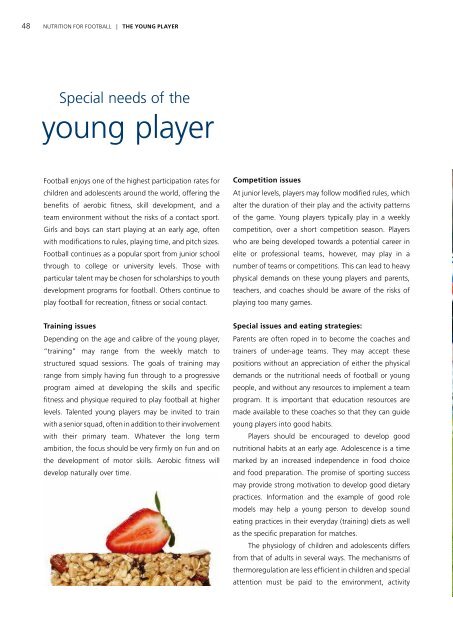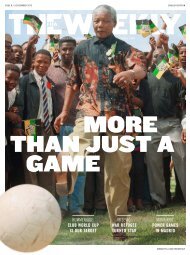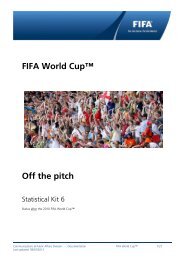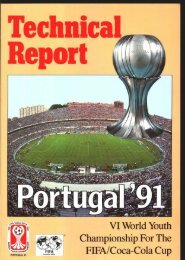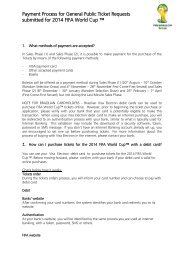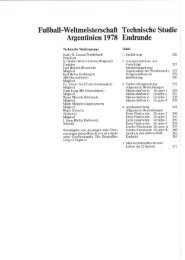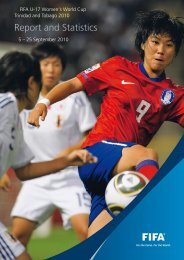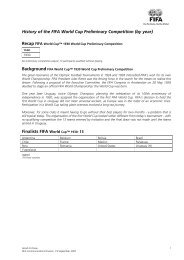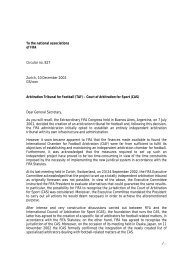Nutrition for football - FIFA.com
Nutrition for football - FIFA.com
Nutrition for football - FIFA.com
Create successful ePaper yourself
Turn your PDF publications into a flip-book with our unique Google optimized e-Paper software.
48 NUTRITION FOR FOOTBALL | thE youNG PlayEr<br />
NUTRITION FOR FOOTBALL | thE youNG PlayEr 49<br />
Special needs of the<br />
young player<br />
Football enjoys one of the highest participation rates <strong>for</strong><br />
children and adolescents around the world, offering the<br />
benefits of aerobic fitness, skill development, and a<br />
team environment without the risks of a contact sport.<br />
Girls and boys can start playing at an early age, often<br />
with modifications to rules, playing time, and pitch sizes.<br />
Football continues as a popular sport from junior school<br />
through to college or university levels. Those with<br />
particular talent may be chosen <strong>for</strong> scholarships to youth<br />
development programs <strong>for</strong> <strong>football</strong>. Others continue to<br />
play <strong>football</strong> <strong>for</strong> recreation, fitness or social contact.<br />
training issues<br />
Depending on the age and calibre of the young player,<br />
“training” may range from the weekly match to<br />
structured squad sessions. The goals of training may<br />
range from simply having fun through to a progressive<br />
program aimed at developing the skills and specific<br />
fitness and physique required to play <strong>football</strong> at higher<br />
levels. Talented young players may be invited to train<br />
with a senior squad, often in addition to their involvement<br />
with their primary team. Whatever the long term<br />
ambition, the focus should be very firmly on fun and on<br />
the development of motor skills. Aerobic fitness will<br />
develop naturally over time.<br />
<strong>com</strong>petition issues<br />
At junior levels, players may follow modified rules, which<br />
alter the duration of their play and the activity patterns<br />
of the game. Young players typically play in a weekly<br />
<strong>com</strong>petition, over a short <strong>com</strong>petition season. Players<br />
who are being developed towards a potential career in<br />
elite or professional teams, however, may play in a<br />
number of teams or <strong>com</strong>petitions. This can lead to heavy<br />
physical demands on these young players and parents,<br />
teachers, and coaches should be aware of the risks of<br />
playing too many games.<br />
Special issues and eating strategies:<br />
Parents are often roped in to be<strong>com</strong>e the coaches and<br />
trainers of under-age teams. They may accept these<br />
positions without an appreciation of either the physical<br />
demands or the nutritional needs of <strong>football</strong> or young<br />
people, and without any resources to implement a team<br />
program. It is important that education resources are<br />
made available to these coaches so that they can guide<br />
young players into good habits.<br />
Players should be encouraged to develop good<br />
nutritional habits at an early age. Adolescence is a time<br />
marked by an increased independence in food choice<br />
and food preparation. The promise of sporting success<br />
may provide strong motivation to develop good dietary<br />
practices. In<strong>for</strong>mation and the example of good role<br />
models may help a young person to develop sound<br />
eating practices in their everyday (training) diets as well<br />
as the specific preparation <strong>for</strong> matches.<br />
The physiology of children and adolescents differs<br />
from that of adults in several ways. The mechanisms of<br />
thermoregulation are less efficient in children and special<br />
attention must be paid to the environment, activity


